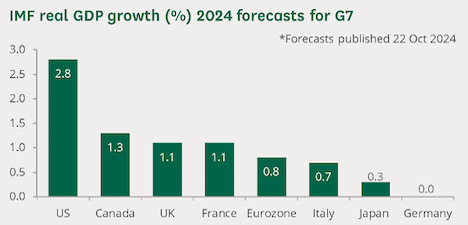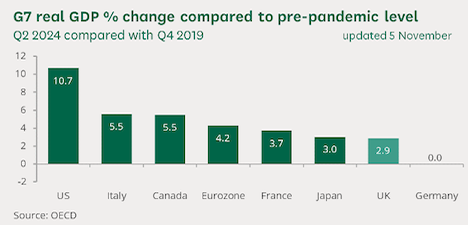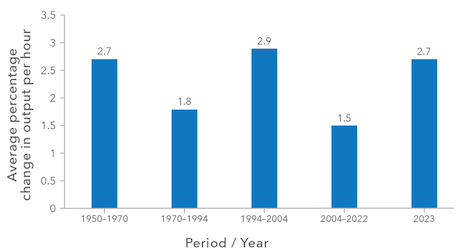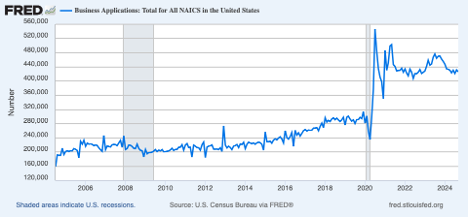What’s behind US’s economic growth?

What’s behind US’s economic growth?
November 15 | By Dean Sevin Yeltekin
In this blog, Dean Sevin Yeltekin points to productivity as the key ingredient that drives US economic growth.
Lately, watching the US in the global economic growth race is a bit like watching Katie Ledecky swim the 1500m in the Olympics. One front runner surges ahead, lapping the others, while a school of swimmers or countries try desperately to catch up.
Recent data demonstrates that whether you look at projected annual growth rates, or the change relative to the pre-pandemic levels, the US wins the race, and by a large margin.

| 
|
What fuels this economic growth in the US? What is the US’s secret sauce?
If you don’t want to read any further, and want a one-word answer, here it is for you: Productivity.
To be more precise: labor productivity, measured by output per hour worked. In a nutshell, we are growing faster than our peers, because we are producing more stuff per hour. American workers have increased their productivity by an astonishing 73% since 1990 while their European counterparts achieved a 39% increase during the same period.
It has not been always a smooth ride for the US workers. The US productivity growth has gone through its peaks and valleys over the years. The two and a half decades post-WWII saw a significant production boom followed by a stagnation in productivity that started in the 70s and lasted until the mid-90s. During the Internet and dot-com era, productivity surged right before and right after we entered the new millennium. Then, despite what felt like a fast-moving technology age, productivity slowed down again between 2004 and 2022.
After nearly decades, that trend is showing signs of reversing. Starting in 2023, we are again seeing a decent productivity surge. That surge has been continuing through the second and third quarters of 2024, at an annualized rate of 2.1 and 2.2% respectively.

It may be tempting to jump in and credit Generative AI (GenAI) for making workers productive, but it’s too early for GenAI to be responsible for the surge. The timing simply doesn’t line up. We may also want to argue that the rise of flexible work arrangements, which remove geographic barriers, raised the efficiency of the labor market. But the data on the productivity effects of work-from-home arrangements are mixed.
Still, these arguments would still get you partial credit. At their core, they relay something about the American labor markets and firms: the amount of churn. The process of creative destruction sees newer, more efficient businesses replacing older, less efficient ones, in large part by introducing new technology and innovation. This innovation inspires existing companies to step up their game, increasing overall productivity. The more new businesses succeed and thrive, the more they push the economy to evolve.
When we see the recent new business formation numbers in the US, it’s hard not to notice that recent discrete jump.

The Bottom Line
Growth in labor productivity is one major way the US economy can grow without contributing to higher inflation—a welcome lever to pull in a time when inflation is still making many consumers feel worse off than they were a few years ago. The uptick in new business creation seems to be reversing decades of stagnation in productivity, turbocharging US economic growth beyond all expectations. As long as productivity continues to rise, we will continue to see the US economy lap the competition.


Sevin Yeltekin is the Dean of Simon Business School.
Follow the Dean’s Corner blog for more expert commentary on timely topics in business, economics, policy, and management education. To view other blogs in this series, visit the Dean's Corner Main Page.











